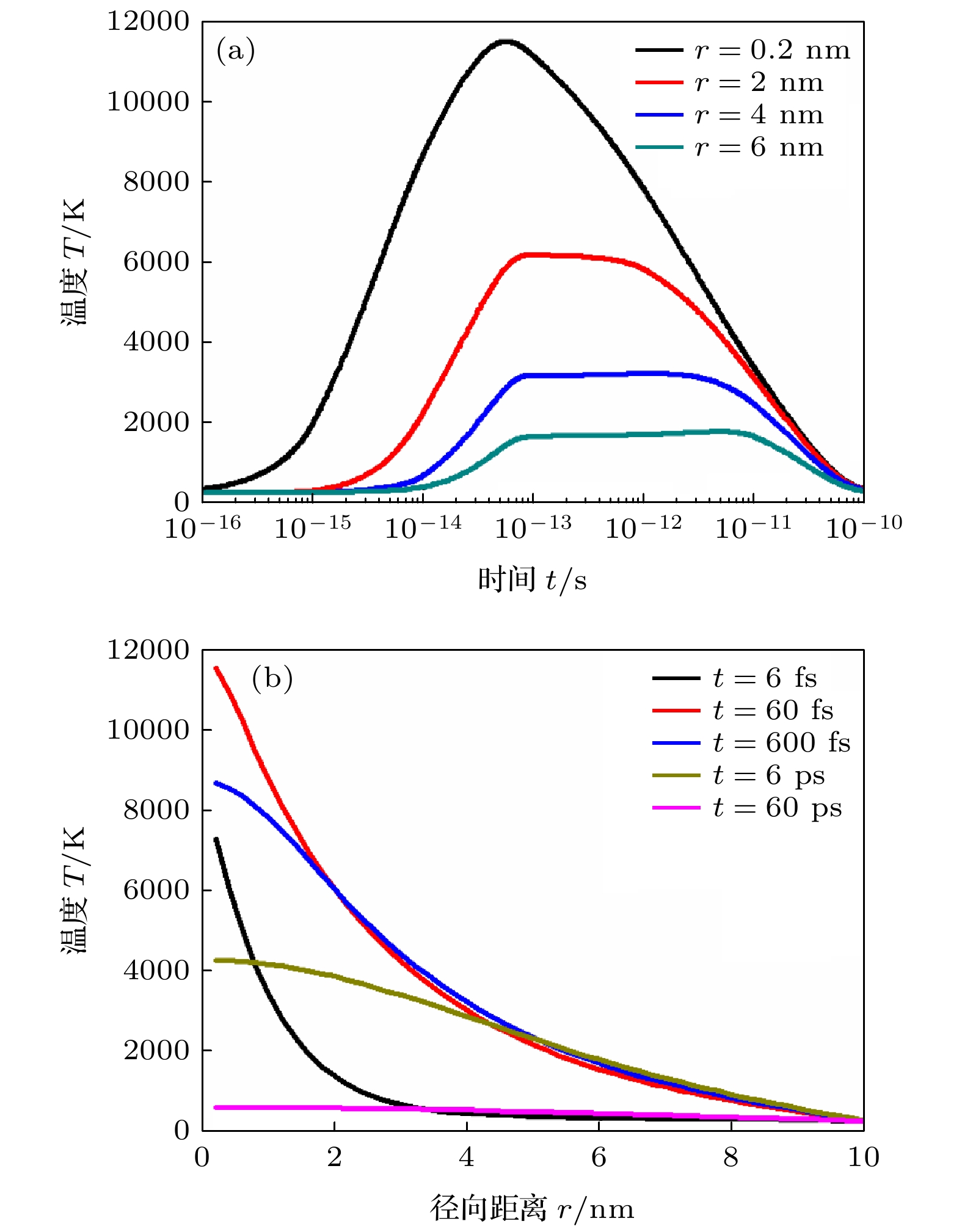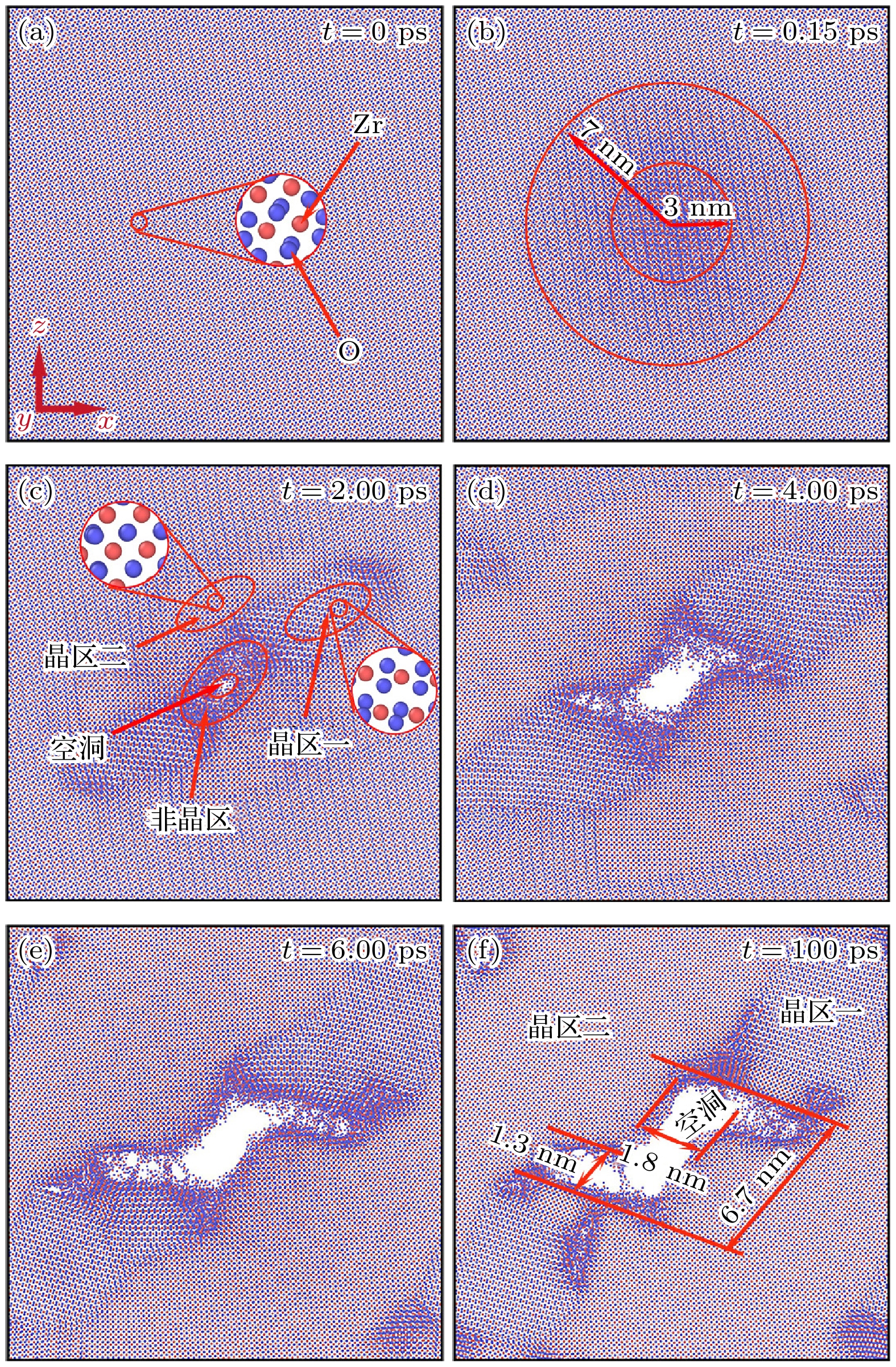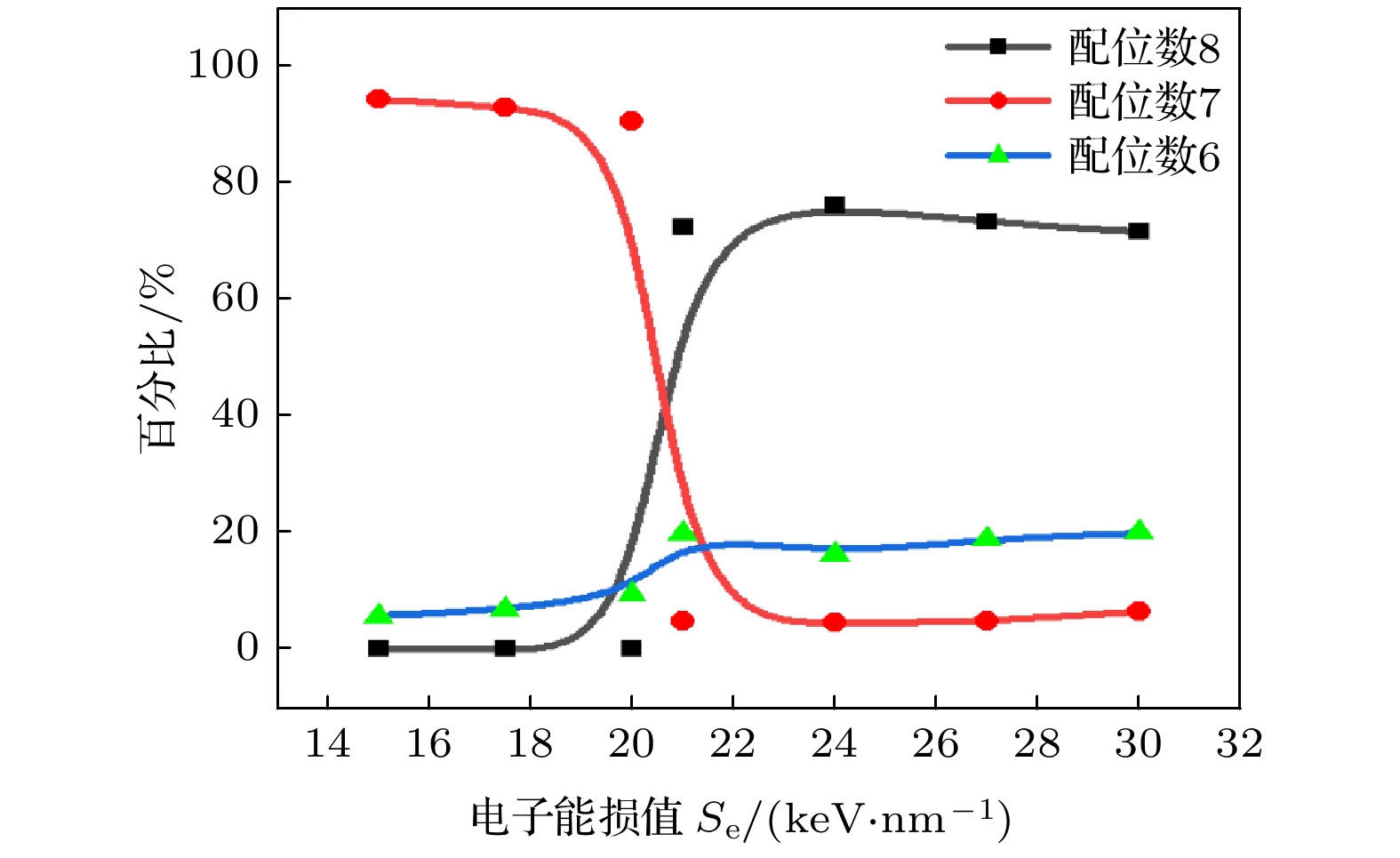-
ZrO2陶瓷耐高温、耐腐蚀、抗辐照性能强, 是极具前景的反应堆惰性基质燃料和锕系元素固化材料. 本文联合使用热峰模型和分子动力学方法, 模拟了核辐射环境下ZrO2的相变过程: 基于热峰模型, 从快速重离子注入后能量沉积和传导的多物理过程出发, 建立热扩散方程, 求得ZrO2晶格温度时空演变特性; 然后运用分子动力学方法模拟了该热峰作用下, 单斜ZrO2相变的微观物理过程. 研究发现, 电子能损为30 keV·nm–1的单一快速重离子注入后, ZrO2中心产生一个半径为7 nm的柱形径迹, 径迹中心晶格迅速熔融, Zr原子配位数由7降至4—6, 2 ps时开始结晶并形成空洞, 空洞周围为非晶区, 非晶区外Zr原子配位数变为8, 同时X射线衍射(X-ray diffraction, XRD)计算和分析结果确认发生了单斜相向四方相的转变. 随着热峰能量向周围传递, 相变区逐渐扩大. 经热峰计算和分子动力学模拟, 辐照诱导ZrO2由单斜相转为四方相的快速重离子的电子能损阈值为21 keV·nm–1.Owing to its excellent corrosion, radiation and high temperature resistance, ZrO2 has been considered as a strong candidate material for inert fuel for the incineration of actinides. In this paper, a combination of thermal spike model and molecular dynamics is used to simulate the phase transition process of ZrO2 in the nuclear radiation environment. Based on the thermal spike model, two coupled diffusion equations are established with considering the multiple physical process of energy deposition and transmission after the implantation of swift heavy ions into target material. The space-time evolution characteristics of ZrO2 lattice temperature are obtained by solving the coupled diffusion equations numerically. Then the phase transformation of ZrO2 form monoclinic phase to tetragonal phase under the thermal spike is investigated on an atomic scale by means of molecular dynamics. It is found that a cylindrical track with a radius of 7 nm is generated in the center of ZrO2 after the implantation of swift heavy ion with an electronic energy loss of 30 keV·nm–1. The lattice melts immediately in the center of track, accompanied with the coordination number of Zr decreasing from 7 to 4–6. Then at about 2 ps, the melting zone gradually turns cool and recrystallized. And in the center of the melting zone, voids begin to form and are surrounded by a highly disordered amorphous region. Meanwhile, tetragonal phase of ZrO2, whose coordination number of Zr is 8, is formed at the periphery of the amorphous region, which is also confirmed by the XRD calculation results. As energy transfers from track center to the surround, the tetragonal region gradually develops into the whole system, accompanied with the increase of voids size. The simulation results indicate that the irradiation of ZrO2 with swift heavy ions can lead to a transformation from the monoclinic to the tetragonal phase when the deposited electronic energy loss exceeds an effective threshold ~21 keV·nm–1, greater than the experimental value (12 keV·nm–1), which was mainly due to the large difference between the simulated and measured incident ion fluences and the accuracy of the force field used in the molecular dynamics.
-
Keywords:
- ZrO2 /
- phase transition /
- thermal spike /
- molecular dynamics
[1] Lee Y W, Joung C Y, Kim S H, Lee S C 2001 Met. Mater. Int. 7 159
 Google Scholar
Google Scholar
[2] Aoki T, Sagara H, Han C Y 2019 Ann. Nucl. Energy 126 427
 Google Scholar
Google Scholar
[3] Guo T, Wang C, Lü J, Liang T X 2016 J. Nucl. Mater. 481 66
 Google Scholar
Google Scholar
[4] Nandi C, Grover V, Bhandari K, Bhattacharya S, Mishra S, Banerjee J, Prakash A, Tyagi A K 2018 J. Nucl. Mater. 508 82
 Google Scholar
Google Scholar
[5] Kelly P M, Rose L R F 2002 Prog. Mater. Sci. 47 463
 Google Scholar
Google Scholar
[6] Gong X, Ding S R, Zhao Y M, Huo Y Z, Zhang L, LI Y M 2013 Mech. Mater. 65 110
 Google Scholar
Google Scholar
[7] Benyagoub A, Levesque F, Couvreur F, Gibert-Mougel C, Dufour C, Paumier E 2000 Appl. Phys. Lett. 77 3197
 Google Scholar
Google Scholar
[8] Benyagoub A 2006 Nucl. Instrum. Methods Phys. Res., Sect. B 245 225
 Google Scholar
Google Scholar
[9] Benyagoub A 2010 Nucl. Instrum. Methods Phys. Res., Sect. B 268 2968
 Google Scholar
Google Scholar
[10] Schuster B, Fujara F, Merk B, Neumann R, Seidl T, Trautmann C 2012 Nucl. Instrum. Methods Phys. Res., Sect. B 277 45
 Google Scholar
Google Scholar
[11] Manzini A M, Alurralde M A, Giménez G, Luca V 2016 J. Nucl. Mater. 482 175
 Google Scholar
Google Scholar
[12] O'Connell J H, Lee M E, Skuratov V A, Rymzhanov R A 2020 Nucl. Instrum. Methods Phys. Res., Sect. B 473 1
 Google Scholar
Google Scholar
[13] Benyagoub A 2005 Phys. Rev. B 72 094114
 Google Scholar
Google Scholar
[14] Lu F Y, Wang J W, Lang M, Toulemonde M, Namavar F, Trautmann C, Zhang J M, Ewing R C, Lian J 2012 Phys. Chem. Chem. Phys. 14 12295
 Google Scholar
Google Scholar
[15] Sharma A, Varshney M, Shin H J, Kumar Y, Gautam S, Chae K H 2014 Chem. Phys. Lett. 592 85
 Google Scholar
Google Scholar
[16] Wang J W, Lang M, Ewing R C, Becker U 2013 J. Phys. Condens. Matter 25 135001
 Google Scholar
Google Scholar
[17] 王成龙, 王庆宇, 张跃, 李忠宇, 洪兵, 苏折, 董良 2014 物理学报 63 153402
 Google Scholar
Google Scholar
Wang C L, Wang Q Y, Zhang Y, Li Z Y, Hong B, Su Z, Dong L 2014 Acta Phys. Sin. 63 153402
 Google Scholar
Google Scholar
[18] 袁伟, 彭海波, 杜鑫, 律鹏, 沈扬皓, 赵彦, 陈亮, 王铁山 2017 物理学报 66 106102
 Google Scholar
Google Scholar
Yuan W, Peng H B, Du X, Lv P, Shen Y H, Zhao Y, Chen L, Wang T S 2017 Acta Phys. Sin. 66 106102
 Google Scholar
Google Scholar
[19] Toulemonde M, Trautmann C, Balanzat E, Hjort K, Weidinger A 2004 Nucl. Instrum. Methods Phys. Res., Sect. B 216 1
 Google Scholar
Google Scholar
[20] Meftah A, Costantini J M, Khalfaoui N, Boudjadar S, Stoquert J P, Studer F, Toulemonde M 2005 Nucl. Instrum. Methods Phys. Res., Sect. B 237 563
 Google Scholar
Google Scholar
[21] Stodel C, Toulemonde M, Fransen C, Jacquot B, Clément C, Frémont G, Michel M, Dufour C 2018 29th International Conference of the International Nuclear Target Development Society East Lansing, Michigan, United States of America, October 7–12, 2018 p05001
[22] Toulemonde M, Dufour Ch, Meftah A, Paumier E 2000 Nucl. Instrum. Methods Phys. Res., Sect. B 166 903
 Google Scholar
Google Scholar
[23] Coughlin J P, King E G 1950 J. Am. Chem. Soc. 72 2262
 Google Scholar
Google Scholar
[24] Kim W K, Shim J H, Kaviany M 2016 J. Nucl. Mater. 491 126
 Google Scholar
Google Scholar
[25] Sobolev V, Lemehov S 2006 J. Nucl. Mater. 352 300
 Google Scholar
Google Scholar
[26] Mévrel R, Laizet J C, Azzopardi A, Leclercq B, Poulain M, Lavigne O, Demange D 2004 J. Eur. Ceram. Soc. 24 3081
 Google Scholar
Google Scholar
[27] Ziegler J F, Ziegler M D, Biersack J P 2008 Nucl. Instrum. Methods Phys. Res., Sect. B 268 1818
 Google Scholar
Google Scholar
[28] Plimpton S 1995 J. Comput. Phys. 117 1
 Google Scholar
Google Scholar
[29] Buckingham R A 1938 Proc. R. Soc. London, Ser. A 168 264
 Google Scholar
Google Scholar
[30] Houska J 2016 Comput. Mater. Sci. 111 209
 Google Scholar
Google Scholar
[31] López P, Pelaz L, Santos I, Marqués L A, Aboy M 2012 J. Appl. Phys. 111 033519
 Google Scholar
Google Scholar
[32] Nordlund K 1995 Comput. Mater. Sci. 3 448
 Google Scholar
Google Scholar
[33] Coleman S P, Sichani M M, Spearot D E 2014 JOM 66 408
 Google Scholar
Google Scholar
[34] 杨辉, 冯泽华, 王贺然, 张云鹏, 陈铮, 信天缘, 宋小蓉, 吴璐, 张静 2021 物理学报 70 054601
 Google Scholar
Google Scholar
Yang H, Feng Z H, Wang H R, Zhang Y P, Chen Z, Xin T Y, Song X R, Wu L, Zhang J 2021 Acta Phys. Sin. 70 054601
 Google Scholar
Google Scholar
[35] Szenes G 1995 Phys. Rev. B 51 8026
 Google Scholar
Google Scholar
-
图 6 不同时刻不同配位数Zr原子空间分布. 所有原子沿离子入射方向投影在(010)平面上, 颜色不同代表配位数不同
Fig. 6. Spatial distribution of Zr atoms with different coordination number at various times. All the atoms are projected on (010) plane along the injection direction of thermal spike. Different coordination numbers are distinguished by the atomic color.
图 8 不同配位数Zr原子空间分布 (a) 电子能损值为20 keV·nm–1; (b)电子能损值为21 keV·nm–1. 所有原子沿离子入射方向投影在(010)平面上, 颜色不同代表配位数不同
Fig. 8. Spatial distribution of Zr atoms with different coordination number: (a) Se = 20 keV nm–1; (b) Se = 21 keV nm–1. All the atoms are projected on (010) plane along the injection direction of thermal spike. Different coordination numbers are distinguished by the atomic color.
-
[1] Lee Y W, Joung C Y, Kim S H, Lee S C 2001 Met. Mater. Int. 7 159
 Google Scholar
Google Scholar
[2] Aoki T, Sagara H, Han C Y 2019 Ann. Nucl. Energy 126 427
 Google Scholar
Google Scholar
[3] Guo T, Wang C, Lü J, Liang T X 2016 J. Nucl. Mater. 481 66
 Google Scholar
Google Scholar
[4] Nandi C, Grover V, Bhandari K, Bhattacharya S, Mishra S, Banerjee J, Prakash A, Tyagi A K 2018 J. Nucl. Mater. 508 82
 Google Scholar
Google Scholar
[5] Kelly P M, Rose L R F 2002 Prog. Mater. Sci. 47 463
 Google Scholar
Google Scholar
[6] Gong X, Ding S R, Zhao Y M, Huo Y Z, Zhang L, LI Y M 2013 Mech. Mater. 65 110
 Google Scholar
Google Scholar
[7] Benyagoub A, Levesque F, Couvreur F, Gibert-Mougel C, Dufour C, Paumier E 2000 Appl. Phys. Lett. 77 3197
 Google Scholar
Google Scholar
[8] Benyagoub A 2006 Nucl. Instrum. Methods Phys. Res., Sect. B 245 225
 Google Scholar
Google Scholar
[9] Benyagoub A 2010 Nucl. Instrum. Methods Phys. Res., Sect. B 268 2968
 Google Scholar
Google Scholar
[10] Schuster B, Fujara F, Merk B, Neumann R, Seidl T, Trautmann C 2012 Nucl. Instrum. Methods Phys. Res., Sect. B 277 45
 Google Scholar
Google Scholar
[11] Manzini A M, Alurralde M A, Giménez G, Luca V 2016 J. Nucl. Mater. 482 175
 Google Scholar
Google Scholar
[12] O'Connell J H, Lee M E, Skuratov V A, Rymzhanov R A 2020 Nucl. Instrum. Methods Phys. Res., Sect. B 473 1
 Google Scholar
Google Scholar
[13] Benyagoub A 2005 Phys. Rev. B 72 094114
 Google Scholar
Google Scholar
[14] Lu F Y, Wang J W, Lang M, Toulemonde M, Namavar F, Trautmann C, Zhang J M, Ewing R C, Lian J 2012 Phys. Chem. Chem. Phys. 14 12295
 Google Scholar
Google Scholar
[15] Sharma A, Varshney M, Shin H J, Kumar Y, Gautam S, Chae K H 2014 Chem. Phys. Lett. 592 85
 Google Scholar
Google Scholar
[16] Wang J W, Lang M, Ewing R C, Becker U 2013 J. Phys. Condens. Matter 25 135001
 Google Scholar
Google Scholar
[17] 王成龙, 王庆宇, 张跃, 李忠宇, 洪兵, 苏折, 董良 2014 物理学报 63 153402
 Google Scholar
Google Scholar
Wang C L, Wang Q Y, Zhang Y, Li Z Y, Hong B, Su Z, Dong L 2014 Acta Phys. Sin. 63 153402
 Google Scholar
Google Scholar
[18] 袁伟, 彭海波, 杜鑫, 律鹏, 沈扬皓, 赵彦, 陈亮, 王铁山 2017 物理学报 66 106102
 Google Scholar
Google Scholar
Yuan W, Peng H B, Du X, Lv P, Shen Y H, Zhao Y, Chen L, Wang T S 2017 Acta Phys. Sin. 66 106102
 Google Scholar
Google Scholar
[19] Toulemonde M, Trautmann C, Balanzat E, Hjort K, Weidinger A 2004 Nucl. Instrum. Methods Phys. Res., Sect. B 216 1
 Google Scholar
Google Scholar
[20] Meftah A, Costantini J M, Khalfaoui N, Boudjadar S, Stoquert J P, Studer F, Toulemonde M 2005 Nucl. Instrum. Methods Phys. Res., Sect. B 237 563
 Google Scholar
Google Scholar
[21] Stodel C, Toulemonde M, Fransen C, Jacquot B, Clément C, Frémont G, Michel M, Dufour C 2018 29th International Conference of the International Nuclear Target Development Society East Lansing, Michigan, United States of America, October 7–12, 2018 p05001
[22] Toulemonde M, Dufour Ch, Meftah A, Paumier E 2000 Nucl. Instrum. Methods Phys. Res., Sect. B 166 903
 Google Scholar
Google Scholar
[23] Coughlin J P, King E G 1950 J. Am. Chem. Soc. 72 2262
 Google Scholar
Google Scholar
[24] Kim W K, Shim J H, Kaviany M 2016 J. Nucl. Mater. 491 126
 Google Scholar
Google Scholar
[25] Sobolev V, Lemehov S 2006 J. Nucl. Mater. 352 300
 Google Scholar
Google Scholar
[26] Mévrel R, Laizet J C, Azzopardi A, Leclercq B, Poulain M, Lavigne O, Demange D 2004 J. Eur. Ceram. Soc. 24 3081
 Google Scholar
Google Scholar
[27] Ziegler J F, Ziegler M D, Biersack J P 2008 Nucl. Instrum. Methods Phys. Res., Sect. B 268 1818
 Google Scholar
Google Scholar
[28] Plimpton S 1995 J. Comput. Phys. 117 1
 Google Scholar
Google Scholar
[29] Buckingham R A 1938 Proc. R. Soc. London, Ser. A 168 264
 Google Scholar
Google Scholar
[30] Houska J 2016 Comput. Mater. Sci. 111 209
 Google Scholar
Google Scholar
[31] López P, Pelaz L, Santos I, Marqués L A, Aboy M 2012 J. Appl. Phys. 111 033519
 Google Scholar
Google Scholar
[32] Nordlund K 1995 Comput. Mater. Sci. 3 448
 Google Scholar
Google Scholar
[33] Coleman S P, Sichani M M, Spearot D E 2014 JOM 66 408
 Google Scholar
Google Scholar
[34] 杨辉, 冯泽华, 王贺然, 张云鹏, 陈铮, 信天缘, 宋小蓉, 吴璐, 张静 2021 物理学报 70 054601
 Google Scholar
Google Scholar
Yang H, Feng Z H, Wang H R, Zhang Y P, Chen Z, Xin T Y, Song X R, Wu L, Zhang J 2021 Acta Phys. Sin. 70 054601
 Google Scholar
Google Scholar
[35] Szenes G 1995 Phys. Rev. B 51 8026
 Google Scholar
Google Scholar
计量
- 文章访问数: 10663
- PDF下载量: 244
- 被引次数: 0














 下载:
下载:







